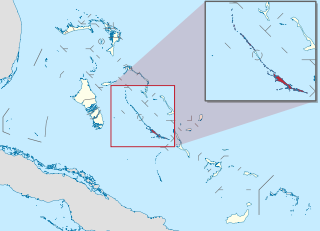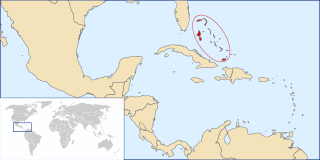Related Research Articles

The Bahamas, known officially as the Commonwealth of The Bahamas, is a country within the Lucayan Archipelago of the West Indies in the Atlantic. It takes up 97% of the Lucayan Archipelago's land area and is home to 88% of the archipelago's population. The archipelagic state consists of more than 700 islands, cays, and islets in the Atlantic Ocean, and is located north of Cuba and northwest of the island of Hispaniola and the Turks and Caicos Islands, southeast of the American state of Florida, and east of the Florida Keys. The capital is Nassau on the island of New Providence. The Royal Bahamas Defence Force describes The Bahamas' territory as encompassing 470,000 km2 (180,000 sq mi) of ocean space.
The Lucayanpeople were the original residents of the Bahamas before the European conquest of the Americas. They were a branch of the Tainos who inhabited most of the Caribbean islands at the time. The Lucayans were the first indigenous Americans encountered by Christopher Columbus. Shortly after contact, the Spanish kidnapped and enslaved Lucayans, with the genocide culminating in complete eradication of Lucayan people from the Bahamas by 1520.

Andros Island is an archipelago within the Bahamas, the largest of the Bahamian Islands. Politically considered a single island, Andros in total has an area greater than all the other 700 Bahamian islands combined. The land area of Andros consists of hundreds of small islets and cays connected by mangrove estuaries and tidal swamplands, together with three major islands: North Andros, Mangrove Cay, and South Andros. The three main islands are separated by "bights", estuaries that trifurcate the island, connecting the island's east and west coasts. It is 167 kilometres (104 mi) long by 64 km (40 mi) wide at the widest point.

The Abaco Islands lie in the northern Bahamas, 180 miles off the South Florida coast. They comprise the main islands of Great Abaco and Little Abaco, along with smaller barrier cays. The northernmost are Walker's Cay, and its sister island Grand Cay. To the south, the next inhabited islands are Spanish Cay and Green Turtle Cay, with its settlement of New Plymouth, Great Guana Cay, private Scotland Cay, Man-O-War Cay, and Elbow Cay, with its settlement of Hope Town. Southernmost are Tilloo Cay and Lubbers Quarters. Another of note off Abaco's western shore is onetime Gorda Cay, now a Disney Island and cruise ship stop and renamed Castaway Cay. Also in the vicinity is Moore's Island. On the Big Island of Abaco is Marsh Harbour, the Abacos' commercial hub and the Bahamas' third largest city, plus the resort area of Treasure Cay. Both have airports. A few mainland settlements of significance are Coopers Town and Fox Town in the north and Cherokee and Sandy Point in the south. Administratively, the Abaco Islands constitute seven of the 31 Local Government Districts of the Bahamas: Grand Cay, North Abaco, Green Turtle Cay, Central Abaco, South Abaco, Moore's Island, and Hope Town.

Exuma is a district of the Bahamas, consisting of over 365 islands, also called cays.

The University of The Bahamas (UB) is the national public institution of higher education in the Commonwealth of The Bahamas with campuses throughout the archipelago. The main campus is located in the capital city of Nassau, on the island of New Providence.

The northern Bahamian rock iguana is a species of lizard of the genus Cyclura that is found on Andros Island and the Exuma islands in the Bahamas. Its status on the IUCN Red List is vulnerable, with a wild population of less than 5,000 animals.

The Bahamian hutia or Ingraham's hutia is a species of hutia in the subfamily Capromyinae native to the Bahamas. Its natural habitats are subtropical or tropical moist lowland forest, subtropical or tropical dry shrubland, and rocky areas.

Cyclura cychlura inornata, the Allen Cays rock iguana or Allen Cays iguana, is a subspecies of the northern Bahamian rock iguana that is found on Allen's Cay and adjacent islands in the Bahamas. Its status in the IUCN Red List is critically endangered, with an estimated wild population of 482–632 animals.

'Cyclura cychlura figginsi, known by the common name of guana and sometimes called the Exuma Island iguana in the international literature, is a subspecies of the northern rock iguana, C. cychlura, that is found on the Exuma island chain in the Bahamas with an estimated wild population of 1,300 animals in 2004, it has been listed on the IUCN Red List as critically endangered.

The following outline is provided as an overview of and topical guide to The Bahamas:

Walker's Cay is the northernmost island in the Bahamas, part of the North Abaco district. Once a popular sport fishing location, the island has been deserted since 2004, following severe hurricane damage. The island is currently undergoing renovation under new ownership.

The following is an alphabetical list of topics related to the Commonwealth of The Bahamas.

The Exuma Cays Land and Sea Park is a protected area in the Exuma Cays of the Bahamas. The protected area extends from Shroud Cay in the north to Bell Cay in the south. The vegetation consists of mangrove communities, with the east sides being clad in low scrub and the western sides with taller scrub. There are many epiphytic orchids and bromeliads.
The Bahamas is a net importer of food, importing almost 90% of its food supply. Of food imports, 80% are from the United States.
Charles Clifford Gordon Chaplin (1906–1991) was an American ichthyologist and author of British origins.

Staniel Cay is an island located in The Exuma Cays, a district of The Bahamas.

West Side National Park is a national park covering the western half of Andros, the Bahamas, and the surrounding waters. The park was established in 2002 and, after being expanded in 2012, has an area of 1,500,000 acres (6,070 km2), being one of the largest protected areas in the region. The park is regarded as a marine protected area, which includes tidal creeks and coastal mangrove forest, as well as an expansive coastal zone.

Pelican Cays Land and Sea Park is a national park in Central Abaco, the Abaco Islands, the Bahamas. The park was established in 1972 and has an area of 2,100 acres (8 km2). The park's marine environment contains an extensive coral reef and undersea cave habitat, which provide opportunities for snorkelling and underwater diving.
References
- ↑ Balfour, Amy C. (2008), "The Bahamas", Caribbean Islands (5th ed.), Lonely Planet Publications Pty Ltd, p. 83, ISBN 978-1-74059-575-9 .